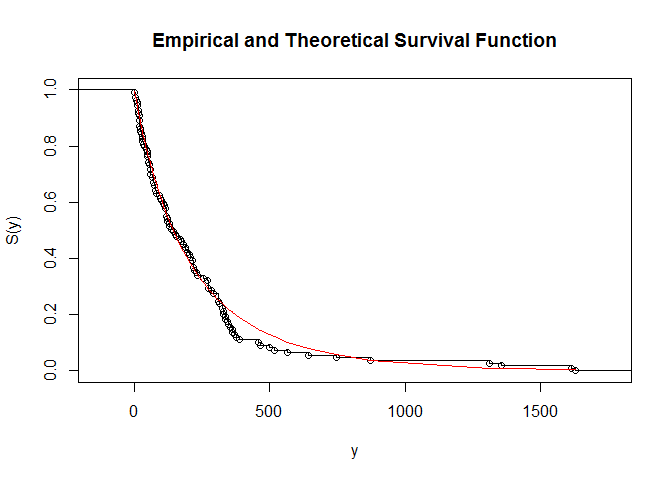Inside the function ecdf only unique values of the argument x are used. In your case length(unique(y)) returns 91.
I've attached a reproducible example.
What I've done: The function ecdf returns a function of class 'ecdf' as it is stated in the description file. So I've used the returned function to compute the empirical cdf of the given data. The survival function is the counterpart of the cdf, i.e. for a random variable X $$ S(x) = 1 - F(x) .$$ I've used this relationship to calculate the empirical survival function.
At the end of the reprex I've created two visualizations to compare the theoretical and empirical distributions.
One more note: The function stepfun which is called inside the plot for the empirical survival function needs a vector y that has one more value than the vector x.
So I put a 1 in front of the survival function. I think that is reasonable, because for values of y smaller than the first value of the ordered sample the empirical survival function should be 1.
# functions:
cdf <- function(y, alpha,lambda) {
if (alpha != 1) {
apecdf <-((alpha^(1-exp(-lambda * y))) - 1)/ (alpha - 1)
} else {
apecdf<- 1-(exp(-lambda * y))
}
return(apecdf)
}
S <- function(y, alpha, lambda) {
if (alpha != 1) {
(alpha / (alpha - 1)) * (1 - alpha^(-exp(-lambda * y)))
} else {
exp(-lambda * y)
}
}
# given:
y <- c(1, 4, 4, 7, 11, 13, 15, 15, 17, 18, 19, 19, 20, 20, 22, 23, 28, 29, 31, 32,
36, 37, 47, 48, 49, 50, 54, 54, 55, 59, 59, 61, 61, 66, 72, 72, 75, 78, 78,
81, 93, 96, 99, 108, 113, 114, 120, 120, 120, 123, 124, 129, 131, 137, 145,
151, 156, 171, 176, 182, 188, 189, 195, 203, 208, 215, 217, 217, 217, 224, 228,
233, 255, 271, 275, 275, 275, 286, 291, 312, 312, 312, 315, 326, 326, 329, 330,
336, 338, 345, 348, 354, 361, 364, 369, 378, 390, 457, 467, 498, 517, 566, 644,
745, 871, 1312, 1357, 1613, 1630)
alpha <- 0.2807
lambda <- 0.0030
# theoretical cdf and survival function for given parameters:
S_th <- S(y = y, alpha = alpha, lambda = lambda)
cdf_th <- cdf(y = y, alpha = alpha, lambda = lambda)
# implementation check, S(x) = 1 - F(x) where F(.) is the cdf:
all.equal(S_th, 1 - cdf_th)
#> [1] TRUE
# empirical cdf and survival function:
## argument x of is specified as a numeric vector of observations; ie. y in your case:
cdf_emp_fun <- ecdf(x = y) # is a function
cdf_emp <- cdf_emp_fun(y) # values
# S as the counterpart of the cdf:
S_emp <- 1 - cdf_emp
# Plotting the cdf:
plot(cdf_emp_fun, main = "Empirical and Theoretical CDF", xlab = "y", ylab = "F(y)") # empirical cdf
lines(x = y, y = cdf_th, col = "red", type = "l") # theoretical cdf

# Plotting the survival functions:
plot(stepfun(x = y, y = c(1, S_emp)), main = "Empirical and Theoretical Survival Function", xlab = "y", ylab = "S(y)") # empirical S
lines(x = y, y = S_th, col = "red", type = "l") # theoretical S

Created on 2020-07-16 by the reprex package (v0.3.0)


